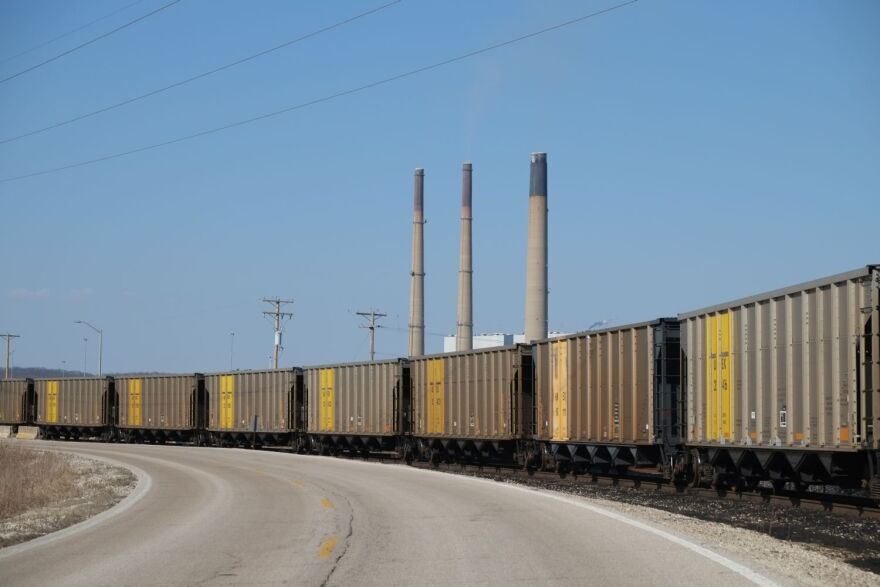In April, Franklin County considered a proposal to ease its restrictions on coal ash landfills. Even though that meeting was open to the public, county residents were not allowed to speak. This Thursday they’ll get their chance.
The all-day hearing with county’s board of commissioners is the latest installment in a six-year battle over Ameren’s plans to build a coal ash landfill next to its power plant in Labadie.
Thursday’s marathon meeting will take place in the commission's chambers on the second floor of Franklin County’s Government Center building at 400 East Locust St. in Union, Mo.
Here’s the agenda:

Why is Franklin County fighting over coal ash?
Before 2011, Franklin County’s zoning regulations didn’t mention landfills — because the county didn’t have any.
But in the summer of 2009, some residents learned that Ameren planned to build a coal ash landfill next to its massive power plant in Labadie. The plant burns about 10 million tons of coal a year, producing more than half a million tons of coal ash.
The residents mobilized to oppose the landfill, forming the Labadie Environmental Organization, also known as LEO. They said building a big coal ash landfill in the floodplain of the Missouri River — and in a potential earthquake zone — would put drinking water supplies at risk.
Coal ash contains hazardous substances like arsenic, chromium and lead. At high enough levels over long enough periods of time, exposure to those contaminants can cause cancer, developmental problems and other serious health issues.
But Ameren said a landfill was needed to replace the plant’s two coal ash ponds, which were filling up. According to the company, the new landfill would be state-of-the-art, with a liner to protect groundwater, a high berm to prevent it from flooding, and a high-tech system to collect contaminated waste water. The existing ponds don't have those protections, and one pond is known to be leaking.
Ultimately, Ameren prevailed. In late 2011, the Franklin County board of commissioners amended the county’s zoning regulations to allow landfills.
But the new regulations also set restrictions on how coal ash landfills could be built and operated. Now the county is considering rolling many of those restrictions back and leaving most of the oversight to state and federal regulators.

What’s prompting another possible change in county landfill regulations?
The Missouri Department of Natural Resources gave Ameren the go-ahead to start building its coal ash landfill in January, when the state agency approved the company’s construction permit.
But Ameren and Franklin County are embroiled in two lawsuits with LEO and Labadie residents over the county’s landfill regulations. Those legal challenges are holding up construction, and it’s possible — though not certain — that changing the county’s regulations could render the lawsuits moot.
What would change, if the county adopts the proposed revisions?
Quite a lot.
If you want to delve into the details, take a look at these redlined versions of the county’s Unified Land-Use Regulations; they show changes to some relevant definitions (Article 2, Section 15) and restrictions (Article 10, Section 236). Coal ash landfills are called “utility waste” landfills in these documents.
Here are some of the main changes under consideration:
- The role of an independent engineer in overseeing the design, construction and operation of the landfill would be substantially curtailed. For example, an independent engineer would no longer have the authority to approve or deny landfill construction plans, require additional groundwater monitoring, or stop any construction that violates county regulations.
- The requirement that the landfill’s base to be at least two feet above groundwater would be eliminated. Both Ameren’s state-approved construction permit and the new federal coal ash rule require that coal ash landfills be built five feet above groundwater. Still, opponents of the landfill worry that if state and federal requirements change in the future, that protection could disappear. Most Franklin County residents get their drinking water from groundwater wells.
- The definition of a landfill “cell” (unit) being “in use” would change substantially. The details of those changes are complicated, but the end result would be that many more cells would be considered “in use” — even those whose construction had barely begun. That’s significant because regulations are often written to apply only to new construction, so an existing landfill cell could be exempt from future county, state or federal regulations on coal ash.

Would any county-level protections remain in place?
Yes.
Again, this list is not all-inclusive, but here are some of the key restrictions that would be retained:
- Coal ash landfills could only be built adjacent to an existing power plant.
- Landfills could only accept coal ash from the adjacent power plant, not from other power plants in Missouri or elsewhere.
- Each landfill cell would need to be surrounded by a berm equal in height to the 500-year flood level (about the height of a two-story building). It's unclear whether coal ash from outside of Franklin County could be brought in to build that berm.
- Coal ash would need to be transported in sealed container trucks, as opposed to dump trucks with tarp coverings.
What’s next after Thursday’s hearing?
The Franklin County Commission will continue to take written comments until 4:30 p.m. on Mon., June 22. Comments can be submitted via email to planningandzoning@franklinmo.net.
The commissioners could vote on the regulation changes as soon as early July. That voting session will likely be open to the public.
Follow Véronique LaCapra on Twitter: @KWMUScience





